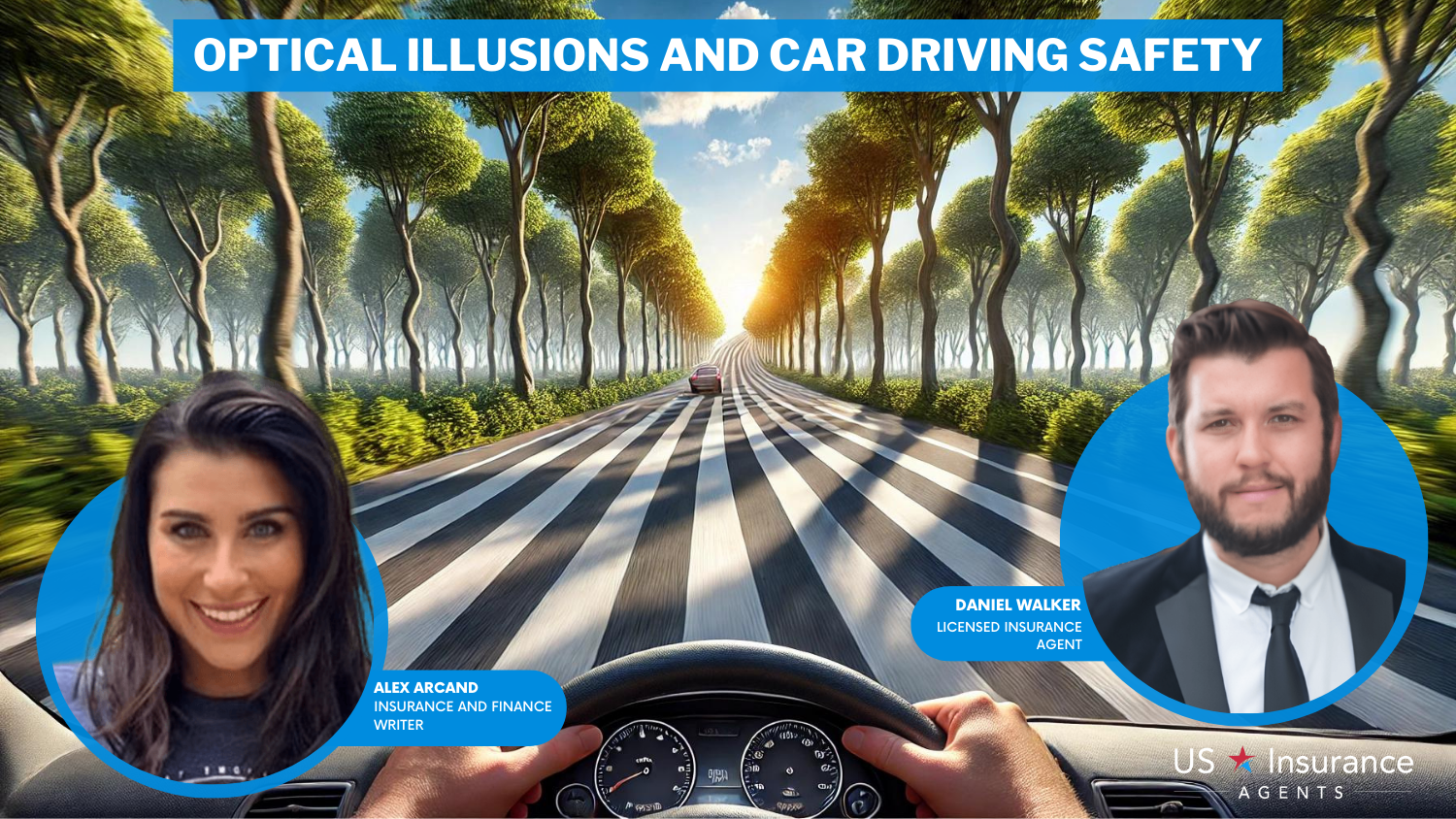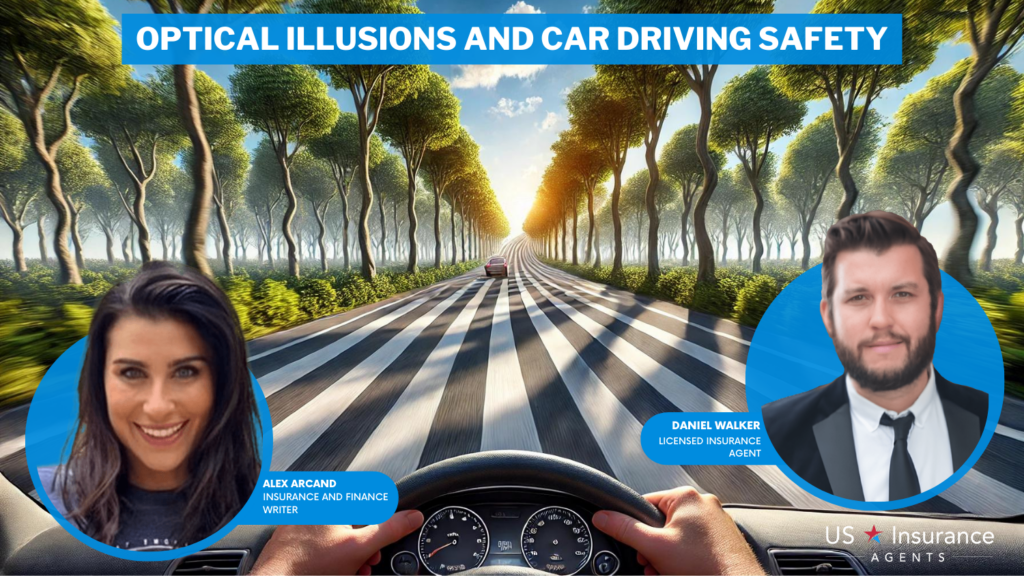Optical Illusions and Car Driving Safety
Optical illusions and car driving safety. Gain valuable insights into various types of visual distortions that can affect your perception on the road. Discover practical strategies to mitigate risks, including maintaining safe distances and addressing blind spots. Stay safe on the road with our comprehensive guide.
Free Auto Insurance Comparison
Compare Quotes From Top Companies and Save
Secured with SHA-256 Encryption

Daniel Walker
Licensed Insurance Agent
Dan Walker graduated with a BS in Administrative Management in 2005 and has been working in his family’s insurance agency, FCI Agency, for 15 years (BBB A+). He is licensed as an agent to write property and casualty insurance, including home, life, auto, umbrella, and dwelling fire insurance. He’s also been featured on sites like Reviews.com and Safeco. He reviews content, ensuring tha...
Licensed Insurance Agent
UPDATED: Oct 1, 2024
It’s all about you. We want to help you make the right coverage choices.
Advertiser Disclosure: We strive to help you make confident insurance decisions. Comparison shopping should be easy. We are not affiliated with any one insurance company and cannot guarantee quotes from any single insurance company.
Our insurance industry partnerships don’t influence our content. Our opinions are our own. To compare quotes from many different insurance companies please enter your ZIP code above to use the free quote tool. The more quotes you compare, the more chances to save.
Editorial Guidelines: We are a free online resource for anyone interested in learning more about insurance. Our goal is to be an objective, third-party resource for everything insurance related. We update our site regularly, and all content is reviewed by insurance experts.
UPDATED: Oct 1, 2024
It’s all about you. We want to help you make the right coverage choices.
Advertiser Disclosure: We strive to help you make confident insurance decisions. Comparison shopping should be easy. We are not affiliated with any one insurance company and cannot guarantee quotes from any single insurance company.
Our insurance industry partnerships don’t influence our content. Our opinions are our own. To compare quotes from many different insurance companies please enter your ZIP code above to use the free quote tool. The more quotes you compare, the more chances to save.
On This Page
Welcome to our comprehensive guide on optical illusions and car driving safety.

In this article, we delve into the intriguing world of optical illusions and how they can impact your safety on the road. We explore various types of visual distortions that drivers may encounter, such as the Ponzo illusion or the motion aftereffect, and their potential effects on perception and judgment while driving. Additionally, we discuss practical tips and strategies to mitigate the risks associated with optical illusions, including maintaining a safe following distance, being mindful of road signs, and staying focused on the task of driving. To ensure you have the necessary protection, we also highlight the importance of having the right insurance coverage.
Don’t wait until it’s too late—enter your ZIP code now to compare rates from the best insurance providers and safeguard yourself against unforeseen circumstances. Your safety matters, and we’re here to help you make informed decisions.
What is an optical illusion?
To understand how optical illusions work, you need an understanding of how your eyes and brain work together in processing visual information. Technically, the human eye can only generate the things it sees in 2D. People are able to see the world in 3D because the brain processes the visual information it receives into 3D. Your eyes and brain usually do a good job of rendering visual information this way, but they are not infallible.
This is where optical illusions come in. Optical illusions are illusions caused by a mismatch between visual perception and reality. These are usually classified into three categories: physical, physiological, and cognitive.
Compare The Best Insurance Quotes In The Country
Compare quotes from the top insurance companies and save!
Secured with SHA-256 Encryption
Resources:
- Northwestern University: Optical illusions and your brain
- Carnegie Mellon University: Understanding optical illusions
- Kent State: Blind spots and the filling-in phenomenon
Motion-Induced Blindness
Motion-induced blindness is a type of optical illusion where static objects seem to disappear when they are juxtaposed with a moving background. The phenomenon was recorded in 1991 by scientists V. S. Ramachandran and Richard l. Gregory. However, the scientific community has not reached a final consensus regarding which neurological mechanisms cause the illusion.
This type of temporary blindness from seeing certain objects or stimuli is often observed by drivers going at high speeds. With attention focused on the road ahead, they tend not to notice a crossing pedestrian, cyclist, or animal that might be right in front of them.
It has also been observed by people driving at night when the taillights of the car in front of them seem to disappear as they turn their attention to the lights of oncoming vehicles in the opposite lane.
Resources:
- University of Washington: Rules of apparent motion
- Skidmore College: Motion perception
Compare The Best Insurance Quotes In The Country
Compare quotes from the top insurance companies and save!
Secured with SHA-256 Encryption
Sloping Roads and Anti-gravity Hills
It seems that every other town has its own anti-gravity hill (also called a spook hill or mysterious hill). Whatever you want to call them, these hills have become popular spots for drivers who want to test out what they often believe to be a strong ‘magnetic field’ in the area which can pull a car (put in neutral) up a seemingly inclined hill.
Unfortunately, scientists have proven that these hills and their alleged magnetic fields are actually just optical illusions. From recreating the topologies of known anti-gravity hills, scientists discovered that the upward movement of a car on an incline is just a product of the eye’s misconception of inclines and false horizons.
Resources:
- University of Maryland Baltimore County: The Bedford County gravity hill
- University of California, Riverside: I know a place where things seem to roll uphill. How does it work?
Judging Distance and Optic Flow
Drivers know how important a good sense of distance and an understanding of optic flow are when it comes to driving and parking. Having both will allow you to avoid hitting road signs, nearby cars, and pedestrians.
It is important to keep in mind that when we are behind the wheel (as opposed to simply walking), we underestimate even the shortest distance by approximately 40% according to research. That is a significant difference that may potentially lead to accidents in situations where only a small amount of error can occur without resulting in a collision.
Compare The Best Insurance Quotes In The Country
Compare quotes from the top insurance companies and save!
Secured with SHA-256 Encryption
Resources:
- Psychonomic Society: Your car tells you what to see: Driving affects distance judgments
- Brown University: Optic flow: A step in the right direction
Vehicle Void Area and Blind Spots
Blind spots are areas on the side of your car that cannot be seen via the side view or rear-view mirrors. These spots also increase depending on the height of the driver and size of the vehicle, and they pose a safety risk to both the driver and other people on the road.
Issues with blind spots typically include not being able to see or judge distance from other objects and blocking the side view of cars in traffic. Although all vehicles have a blind spot, there are still ways you can minimize them.
Some transportation experts recommend using the blind zone/glare elimination (BGE) method. This involves adjusting your outside mirrors 15 degrees further than their usual position to maximize the driver’s view.
Resources:
- AARP: Set your vehicle’s mirrors to limit blind spots
- Consumer Reports: The danger of blind zones
- University of Kansas: Blind zone accidents and how to prevent them
Compare The Best Insurance Quotes In The Country
Compare quotes from the top insurance companies and save!
Secured with SHA-256 Encryption
Positive Use of Optical Illusions to Improve Safety
While some optical illusions pose a danger when it comes to driving safety, they are also being used to improve overall safety on roadways.
Elongated Text on Road Surface: Typically used to inform drivers of speed limits and limitations on intersection turns, these signs employ anamorphosis, or distorted images, to create markings in a way that will make them easily understandable from the perspective of the driver’s seat.
3D Painted Speed Bumps: The U.S. National Highway Traffic Safety Administration has already painted 3D speed bumps in some states to encourage drivers to decrease their speed.
Speed Reduction Markers: The Federal Highway Administration has been working on replicating the evenly spaced painted-on speed reduction markers successfully used in countries like Denmark, France, and the United Kingdom to lower the average driving speeds on the main roadways of rural communities in the US.
Resources:
- Streetsblog NYC: Use your illusion II: Virtual speed humps coming to Philly
- Greater Greater Washington: Optical illusions slow drivers
Frequently Asked Questions
What are optical illusions?
Optical illusions are illusions caused by a mismatch between visual perception and reality. They are classified into three categories: physical, physiological, and cognitive.
How do optical illusions work?
To understand how optical illusions work, you need an understanding of how your eyes and brain work together in processing visual information. Your eyes see in 2D, but your brain processes the visual information into 3D. Optical illusions occur when there is a mismatch between visual perception and reality.
How can optical illusions improve car driving safety?
Some countries have used optical illusions to make drivers more aware of their surroundings, such as 3D painted speed bumps and crosswalks. These illusions make drivers slow down and pay more attention to their surroundings, reducing the risk of accidents.
What is motion-induced blindness?
Motion-induced blindness is a type of optical illusion where static objects seem to disappear when they are juxtaposed with a moving background. This phenomenon is often observed by drivers at high speeds.
Why do sloping roads and anti-gravity hills seem to defy gravity?
Sloping roads and anti-gravity hills are optical illusions where the landscape appears to slope uphill against gravity. However, this is simply an optical illusion caused by the surrounding landscape, and the car is actually going downhill.
Where can I learn more about car driving safety and optical illusions?
You can consult with a local traffic safety organization, or contact your insurance provider to learn more about car driving safety and how optical illusions can improve safety.
Compare The Best Insurance Quotes In The Country
Compare quotes from the top insurance companies and save!
Secured with SHA-256 Encryption
Daniel Walker
Licensed Insurance Agent
Dan Walker graduated with a BS in Administrative Management in 2005 and has been working in his family’s insurance agency, FCI Agency, for 15 years (BBB A+). He is licensed as an agent to write property and casualty insurance, including home, life, auto, umbrella, and dwelling fire insurance. He’s also been featured on sites like Reviews.com and Safeco. He reviews content, ensuring tha...
Licensed Insurance Agent
Editorial Guidelines: We are a free online resource for anyone interested in learning more about insurance. Our goal is to be an objective, third-party resource for everything insurance related. We update our site regularly, and all content is reviewed by insurance experts.